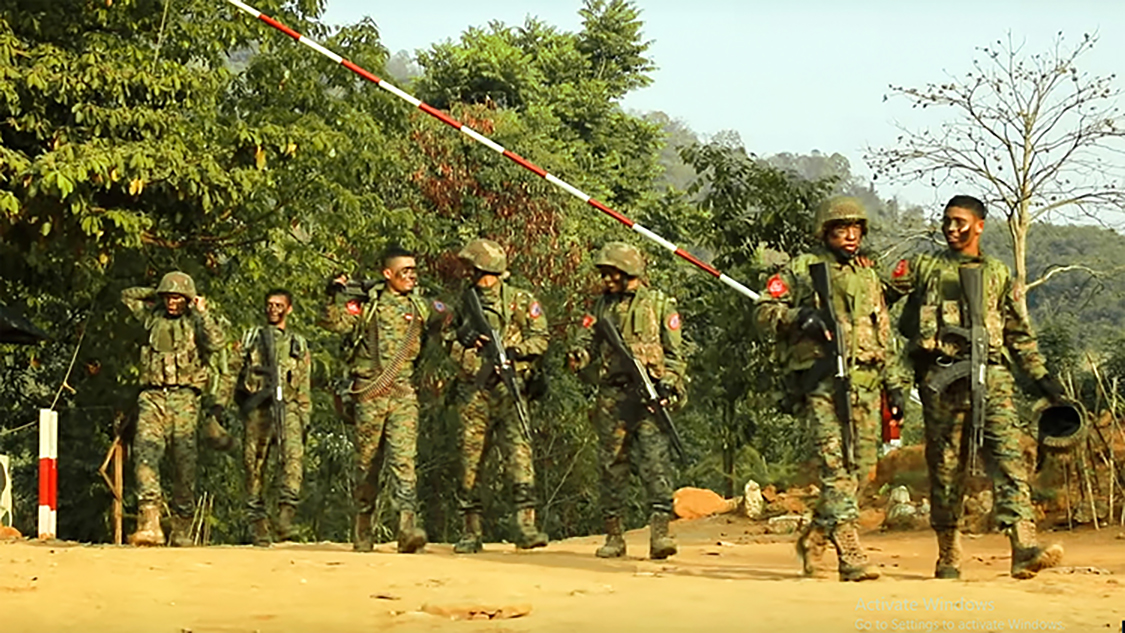Fighting erupted between the Myanmar military and ethnic Rakhine Arakan Army (AA) on November 13, ending a yearlong ceasefire. The latest bout of fighting is the third since late 2018.
After two years of battle, the two sides agreed to a truce ahead of the general election in November 2020. Clashes then broke out again, before an informal ceasefire was called on humanitarian grounds amid food shortages in November last year.
Last year’s fighting broke out as the junta sought to prevent the AA from consolidating administrative control across Rakhine. The ethnic armed group had taken advantage of the truce to install its own administration and courts across rural Rakhine as the regime was busy battling the resistance elsewhere. However, that bout of clashes only lasted for a few months.
In contrast, the fresh fighting is part of a planned and expanding offensive by the AA.
The armed group publicly declared in October last year that it was fighting alongside the Kachin Independence Army (KIA), across the country in Kachin State, northern Myanmar. It also declared that its 10 battalions have joined Operation 1027, the anti-regime offensive launched in northern Shan State by the tripartite Brotherhood Alliance also comprising the Myanmar National Democratic Alliance Army (MNDAA) and Ta’ang National Liberation Army (TNLA).
The junta’s military, which once threatened to crush the AA, did not mention its involvement in Operation 1027 – a sign that it does not want to fight on a new front.

The AA launched its Rakhine offensive one day after the Brotherhood Alliance seized the strategically important town of Kunlong in Shan State on November 12.
But unlike previous fighting in Rakhine, the AA’s ongoing offensive is part of the wider Operation 1027 also being waged by the KIA and People’s Defense Forces, the armed wing of the civilian National Unity Government.
Junta blockades Rakhine front
While the Brotherhood Alliance has cut transport routes in northern Shan State, the junta has blockaded roads and waterways in coastal Rakhine State. Relying on its navy to deliver food, reinforcements and weapons to troops, the regime blocked roads between towns and villages immediately after the AA launched its offensive.
The junta has now isolated towns in Rakhine, imposing its ‘four cuts’ strategy on their civilian populations. It used the same strategy during fighting last year, even restricting the delivery of medicines.
This time, the military has imposed travel restrictions not only in the north but also the south of Rakhine. It has blockaded three key roads linking Rakhine State with Yangon and other parts of the country.

However, beyond the towns, Rakhine is under the control of the AA, which has isolated junta bases. The armed group has also retaken control of the road linking the state capital Sittwe with the central town of Ann. Junta soldiers, police and border guards have been forced to abandon some 40 positions, fleeing to big bases for protection against AA attacks. This has ceded control of territory to the AA.
The regime has deployed troops in towns and strategic hilltops as it braces for an onslaught by AA fighters. Unable to send reinforcements and food supplies by road, the junta has fallen back on its navy and air force for logistics.
The withdrawal of junta troops from vulnerable positions has provided the AA with greater space to maneuver in rural areas. But the concentration of junta forces makes it more difficult for the AA to seize more positions.
Four cuts and genocide
As soon as fighting broke out in Rakhine, the regime cut off supplies of food and medicines from other parts of the country, as well as between towns inside the state. Local people are now facing shortages and price hikes.
The “four cuts” strategy was introduced under Myanmar’s first military dictator, Ne Win, and is designed to sever insurgents’ access to funding, food, intelligence, and recruits. The civilian population in Rakhine are the latest to suffer its strangulating effect.
The fighting remains low-level in Rakhine, but the regime is already targeting civilians. Its troops are shelling villages in Pauktaw, Minbya, Mrauk-U and Kyauktaw townships while detaining civilians as human shields.

In 2017, the same military committed what the UN termed genocide against the Rohingya in Rakhine. It is now planning larger-scale ethnic cleansing against the Rakhine people.
The junta is also targeting civilians on other fronts, including Kachin, Shan, Karenni, Karen, Chin states and Sagaing, Magwe, Mandalay, Bago and Tanintharyi regions. But it exercises more caution in the borderland of northern Shan State, where it has been forced to apologize and offer compensation when its shells killed people on Chinese soil.
Rakhine suffering
Rakhine’s coastal location makes it easier for the regime to implement the “four cuts” strategy with its navy. So, the state is suffering more than other areas.
But the strategy has its own disadvantages since it depends on connectivity among junta administrative organs across the state. The AA needs to find ways to take advantage of vulnerabilities in this chain.
At the same time, the armed group must find solutions that help local people overcome the hardships inflicted by the junta’s travel restrictions.
Ko Oo is an expert in Myanmar’s ethnic affairs.
















